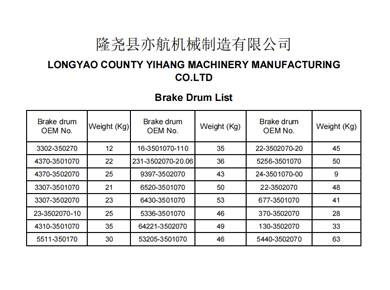Aug . 01, 2024 10:26 Back to list
Step-by-step guide to bleeding brake drums for optimal vehicle performance and safety
How to Bleed Brake Drums A Comprehensive Guide
Maintaining your vehicle's braking system is crucial for ensuring safety on the road. One essential aspect of brake maintenance is bleeding the brake drums. This process helps eliminate air bubbles from the brake fluid, allowing for efficient braking performance. In this article, we’ll walk you through the steps of bleeding brake drums, ensuring your vehicle operates smoothly and effectively.
Understanding Brake Drum Systems
Before delving into the bleeding process, it’s important to recognize how brake drum systems work. Unlike disc brakes, which have a caliper and rotor setup, drum brakes utilize a drum that houses brake shoes that press outward against the drum when you apply the brakes. Over time, air can enter the brake lines, leading to a spongy pedal feel and reduced braking responsiveness. Bleeding the brakes helps to restore the firmness and reliability of the brake system.
Tools and Materials Needed
Before you start, gather the necessary tools and materials - Brake bleeding kit or a clear plastic tube - A wrench or brake line wrench - New brake fluid - A container to catch old fluid - An assistant (for two-person operation) - Safety goggles and gloves for protection
Steps to Bleed Brake Drums
1. Prepare the Vehicle - Ensure the vehicle is on level ground and securely parked. Use wheel chocks to prevent any movement. - Remove the wheel covering the drum brake you intend to bleed.
how to bleed brake drums

2. Locate the Bleed Valve - Find the brake bleeder valve on the brake drum assembly. Typically, it is located on the back of the brake assembly, near the top.
3. Attach Bleeding Kit - Connect the clear plastic tube to the bleeder valve, ensuring it is secure. Place the other end of the tube into a container to catch the fluid that will be released.
4. Check Brake Fluid Level - Open the hood and check the master cylinder’s brake fluid reservoir. If the fluid is low, top it off with the recommended brake fluid type for your vehicle.
5. Begin Bleeding Process - Have your assistant sit in the driver’s seat and pump the brake pedal several times, then hold it down. - While the pedal is held down, open the bleeder valve slightly using your wrench. Allow the old brake fluid and any air to escape into the container. - Close the bleeder valve before your assistant releases the brake pedal. This prevents air from being sucked back into the system.
6. Repeat the Process - Repeat the pumping and bleeding process several times until you see a steady stream of clear brake fluid without air bubbles exiting the tube. - After completing one drum, repeat the process on the remaining drums, starting from the farthest wheel from the master cylinder (typically the passenger side rear, then the driver side rear, then the passenger side front, and finally the driver side front).
7. Final Checks - Once all wheels have been bled, ensure the brake fluid reservoir is topped off again. Check for any leaks around the bleeder valves after the process is complete. - Reinstall the wheel and lower the vehicle safely.
Conclusion
Bleeding brake drums is a vital maintenance task that can significantly enhance your vehicle's braking performance. It’s an accessible process that can often be accomplished at home with the right tools and a bit of patience. Regular maintenance not only prolongs the life of your braking system but also ensures your safety on the road. If you feel uncomfortable performing this task, or if you’re unsure about any steps, don’t hesitate to reach out to a professional mechanic for assistance. Prioritizing your vehicle’s brake system is essential for a safe and enjoyable driving experience.
-
ROR Web Development: Build Fast, Scalable, Secure Apps
NewsAug.17,2025
-
Scania Brake Drums: OEM Quality for Optimal Safety & Durability
NewsAug.16,2025
-
R.V.I: Advanced Remote Visual Inspection for Precision
NewsAug.15,2025
-
Discover HYUNDA: Innovative Vehicles, Equipment & Solutions
NewsAug.14,2025
-
R.V.I: Unlock Advanced Insights & Real-time Performance
NewsAug.13,2025
-
Kamaz Brake Drum: Durable & Reliable for Heavy Duty Trucks
NewsAug.12,2025
